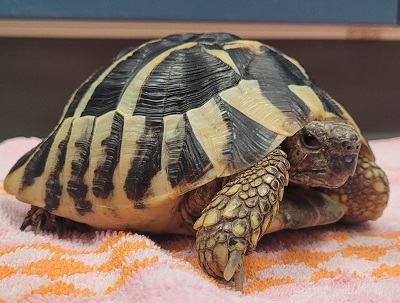
We shell-a-brated Hermann’s tortoises on Twitter as our Animal of the Month for May, but now that the month is almost over it’s time to bid them a fond farewell. If you missed any of our tweets @ExoticPetVets, you can find a summary right here that you can reference any time. Did you know?:
- The Hermann’s tortoise (Testudo hermanni) is a small- to medium-sized tortoise endemic to many parts of countries that make up Mediterranean Europe.
- In the wild, Hermann’s tortoises can be found in parts of Spain, France, Italy, Greece, Serbia, Croatia, Bosnia and Herzegovina, North Macedonia, Montenegro, Romania, Bulgaria, Albania and Turkey.
- There are two subspecies of Hermann’s tortoises currently recognized – the western Hermann’s tortoise (T. h. hermanni) and the eastern Hermann’s tortoise (T. h. boettgeri).
- As their respective names suggest, western Hermann’s tortoises are found in the more western portions of their European range – Spain, Italy and France – while the eastern subspecies is found in the countries to the east.
- The Dalmatian tortoise was once considered to be a third subspecies (formerly T. h. hercegovinensis), but is now regarded as a geographical variant of the eastern Hermann’s tortoise. The Dalmatian tortoise is found in Croatia and Bosnia and Herzegovina.
- The Dalmatian tortoise has characteristics of both the eastern and western Hermann’s tortoise and has been described by some sources as a “middle ground” between the two subspecies.
- In the wild, Hermann’s tortoises can be found in meadows, Mediterranean oak forests, shrubland, agricultural areas, grassy hillsides and rocky slopes.
- In general, wild Hermann’s tortoises avoid moist environments and prefer dry habitats that provide areas where they can hide and find shade.
- The upper shell (carapace) of the Hermann’s tortoise is a yellowish-tan colour with black markings. The lower shell (plastron) is flat in females and concave in males.
- The bony plates on the shells of all tortoises and turtles are called scutes. The supracaudal scute (or shield), which is the scute above the tail, is typically divided in Hermann’s tortoises.
- Hermann’s tortoises have small tails which have a unique horn-like spur at the tip. Males have a larger tail and more prominent spur compared to their female counterparts.
- There are differences between the heads of eastern and western Hermann’s tortoises. The eastern subspecies has a narrow brown-black head with a yellowish spot on either side.
- Western Hermann’s tortoises has a more stout brown-black head. Juveniles will have the yellow spot on either side of their heads, but the spots fade as this subspecies matures.
- When fully grown, female eastern Hermann’s tortoises typically grow to an average length of between 7–9 inches (18-23 cms) and 5–7 inches (13-18 cms) for males.
- Western Hermann’s tortoises are smaller than the eastern subspecies. Females will grow to average lengths of between 5–6 inches (13-15 cms) while males will grow to about 4-5 inches (10-13 cms).
- In addition to the size difference, western Hermann’s tortoises sport a brighter yellow and more striking colour contrast with the black markings on their carapaces compared to the eastern subspecies, whose colours are more muted.
- Even though plant material makes up the vast majority of the Hermann’s tortoise diet, they are not 100% herbivorous.
- In the wild, Hermann’s tortoises will eat succulent plants (plants that can retain water) and herbaceous plants (plants with soft stems). They will also eat weeds, fruits and flowers.
- But wild Hermann’s tortoises may also eat the occasional worm, snail, slug, insect or carrion when the opportunity presents itself.
- Because of their ability to pull their heads and legs into their hard shells, mature Hermann’s tortoises have few predators beyond humans.
- But juvenile Hermann’s tortoises, whose shells are not as hard as mature tortoises, are vulnerable to a number of predators in the wild.
- Rats, wild boar, foxes, badgers, snakes, hedgehogs and magpies are among the known predators of juvenile Hermann’s tortoises.
- May 23rd is a special day – it’s World Turtle Day, which has been celebrated every May 23rd since 2000.
- World Turtle Day was started by American Tortoise Rescue to raise awareness and educate people about the world’s turtles and tortoises and the threats they face every day.
- The IUCN Red List has classified Hermann’s tortoises as “Near Threatened,” which means the wild population is in decline.
- Rampant habitat destruction, pollution, being taken taken from the wild for the pet trade and death from vehicle strikes are major threats to Hermann’s tortoise numbers in the wild.
- Hermann’s tortoises have very long lifespans and it’s estimated that they can live anywhere between 30 and 70 years on average.
- Tommy, a female Hermann’s tortoise living in Britain (Surrey), made the news in 2019 when she celebrated her 121st birthday and was hailed as the world’s oldest living pet at the time. It’s unclear if she is still alive today.
- Thomas, another Hermann’s tortoise living in Britain (Guernsey), passed away in 2013 at the age of 130. He had to be euthanized after a rat bit his leg and the wound became infected.
- Hermann’s tortoises are known for being gentle and laid-back. While they can be picked up, they don’t like being handled and should be mostly left on solid ground where they feel secure.
- If you must handle a Hermann’s tortoise – or any turtle or tortoise – always wash your hands afterwards because of concerns about the Salmonella bacterium.

